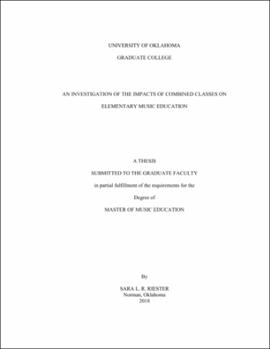| dc.description.abstract | The purpose of this study was to investigate the impacts of combined classes on elementary general music education as well as to gather information about how music educators teaching combined classes in elementary general music were adapting instructional techniques and strategies to successfully deliver instruction and achieve curricular goals in combined classes. To this end, two Oklahoma elementary music teachers from different districts were purposefully selected by their responses to an initial survey to participate in interviews and classroom observations. Over the course of the study, data were gathered through interviews that provided insight into the challenges faced by music educators teaching combined classes and what techniques and strategies they used to be successful with large numbers of students. Classroom observations were conducted to gather additional data on instructional techniques and strategies as well as modifications made to activities to compensate for the effects of combined classes in the elementary general music classroom.
Considering the impacts of combined classes on elementary general music education, the challenges these impacts present in instruction, and the findings of previous studies in class size, single classes with smaller numbers of students are better for student achievement in the music classroom than combined classes with larger numbers of students and should be advocated for whenever possible. However, many factors, such as budget, school population growth, scheduling, and resources, necessitate the combining of homeroom classes for music and other special subject area instruction. Both teachers in this study felt confident in their ability to positively affect student growth and achievement in their combined class settings. Though different in personality and instructional delivery, each teacher had effective classroom management and control in the classroom. Students in both cases were engaged throughout their lessons and showed evidence of conceptual mastery. Strategies compiled from the cases in this study have been presented for teachers to consider when faced with combined classes in elementary general music education to successfully deliver instruction and achieve curricular goals in combined class settings and settings in which circumstances present other non-traditional challenges.
Considering the challenges faced by music educators in combined classes and the modifications to instructional activities and strategies needed to achieve success in such settings, it is recommended that music teacher preparation programs should seek to intentionally provide pre-service teachers with field experiences in music programs with large, combined classes. Due to the frequent variations in circumstances such as (a) class size and composition, (b) frequency and duration of music instruction, (c) physical space constraints, and (d) materials and instruments available, it would benefit pre-service teachers to have field experiences in a wide variety of music programs to prepare them for whatever circumstances they may encounter in their future teaching positions. | en_US |
